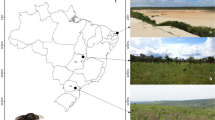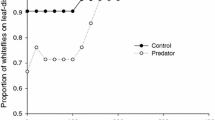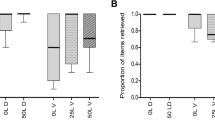Abstract
The adaptive radiation of the angiosperms was strongly affected by fruit and seed dispersal since the establishment of the seedlings is a fundamental process for the recruitment of juveniles to the populations. Among the species of Burseraceae, seeds with fleshy attachments and high caloric value suggest mammaliochory as an ancestral dispersal way. In Protium icicariba, at the same time as there is a visual pattern typical of ornithochory, with a report of effective demonstration, the diaspores present the highest levels of essential oils of the whole plant, suggesting other dispersion processes by olfactory guided vectors. This work aims to monitor the diasporic dispersal process in P. icicariba in situ, aiming to identify dispersers and to investigate the role of the essential oil in the dispersion of diaspores of this plant species. The natural dispersion was monitored in situ, in weekly campaigns throughout eight months, using visual and photographic records, in daily shifts of six hours, distributed along the dawn, morning, afternoon, dusk, and night. We used both direct observation and continuous picture capturing along 43 days with photographic traps. Mature diaspores removed from pseudocapsules were pooled to determine potential dispersers. Artificial models of the diaspores, in white and green colors, were also used to test hypotheses on the role of scent in the dispersion, added 1%, weight/weight, of the essential oil extracted from the mature diaspores, which chemical composition determined by gas chromatography coupled to mass spectrometry. Besides, the analysis of stomach contents of lizards collected in adjacent area was also performed. In daytime and nighttime monitoring in nature, no vertebrates were recorded dispersing diaspores. The most common was the primary wind-facilitated autochory of diaspores to the substrate, near the plant matrices. Secondarily, workers of the ant species Atta robusta can remove the pseudoarils or move the pyrenes to the anthills. The lizard species Tropidurus torquatus ingests pyrenes with the pseudoarils, and the sclerified pericarp of the pyrene is potentially resistant to chemical action of the digestive juices. Ants and lizards have also accessed the caves with natural diaspores. Concerning the artificial diaspore models, ants accessed, indistinctly, white and the green models that contained essential oils. The lizards accessed the white models, with or without essential oils, and showed insignificant access to green ones, with or without essential oil. The ingestion of pyrenes by lizards was also confirmed through analysis of stomach contents. The aggregate spatial pattern of P. icicariba at the study site, associated with clumps, may be derived from germination in the substrate near the matrices, or in the anthills or after diaspora defecation and / or regurgitation of the lizard, which is a species strongly associated with clumps of this vegetation. As the access to the diaspores by ants and lizards depends on the primary autochory, and no impediments to the germination near to the matrix plant were found, the dispersion is compatible with a multifactorial characteristic of the diplochory.




Similar content being viewed by others
References
Acrilex (2008) Massa de Modelar. Ficha de Informações de Segurança de Produtos Químicos. FISPQ n° 070
Adams RP (2009) Identification of essential oil components by gas chromatography/mass spectrometry, 3rd edn. Allured, Illinois
Altmann J (1974) Observational study of behavior: sampling methods. Behaviour 49:227–267. https://doi.org/10.1163/156853974X00534
Bachelier JB, Endress PK (2009) Comparative floral morphology and anatomy of Anacardiaceae and Burseraceae (Sapindales), with a special focus on gynoecium structure and evolution. Bot J Linn Soc 159:499–571. https://doi.org/10.1111/j.1095-8339.2009.00959.x
Baeckens S, Herrel A, Broeckhoven C, Vasilopoulou-Kampitsi M, Huyghe K, Goyebs J, Van Danne R (2017) Evolutionary morphology of the lizard chemosensory system. Sci Rep 7:10141. https://doi.org/10.1038/s41598-017-09415
Bakkali F, Idaomar M, Averbeck D, Averbeck S (2008) Biological effects of essential oils: a review. Food Chem Toxicol 46:446–475. https://doi.org/10.1016/j.fct.2007.09.106
Barroso GM, Morim MP, Peixoto AL, Ichaso CL (2004) Frutos e sementes – Morfologia aplicada à sistemática de dicotiledônea. UFV, Viçosa
Benot ML, Bittebiere AK, Ernoult A, Clément B, Mony C (2013) Fine-scale spatial patterns in grassland communities depend on species clonal dispersal ability and interactions with neighbors. J Ecol 101:626–636. https://doi.org/10.1111/1365-2745.12066
Bleher B, Oberrath R, Böhning-Gaese K (2002) Seed dispersal, breeding system, tree density and the spatial pattern of trees – a simulation approach. Basic Appl Ecol 3:115–123. https://doi.org/10.1078/1439-1791-00088
Brower JE, Zar JH, Ende CNV (1997) Field and laboratory methods for general ecology, 4th edn. McGraw-Hill, Boston
Burton AC, Neilson E, Moreira D, Ladle A, Steenweg R, Fisher JT, Brayne E, Boutin S (2015) Wildlife camera trapping: a review and recommendations for linking surveys to ecological processes. J Trop Ecol 52:675–685. https://doi.org/10.1111/1365-2664.12432
Caissard JC, Joly C, Bergougnoux V, Hugueney P, Mauriat M, Budino S (2004) Secretion mechanisms of volatile organic compounds in specialized cells of aromatic plants. Recent res Devel cell biol 2:1–15
Carvalho AL, Silva HRD, Araújo AF, Alves-Silva R, Silva-Leite RRD (2007) Feeding ecology of Tropidurus torquatus (Wied) (Squamata, Tropiduridae) in two areas with different degrees of conservation in Marambaia Island, Rio de Janeiro, southeastern Brazil. Rev Bras Zoo 24:222–227. https://doi.org/10.1590/S0101-81752007000100029
Cechin SZ, Martins M (2000) Eficiência de armadilhas de queda (pitfall traps) em amostragens de anfíbios e répteis no Brasil. Rev Bras Zoo 17:729–740 https://doi.org/10.1590/S0101-81752000000300017
CEPEMAR (2007) Plano de Manejo do Parque Estadual Paulo César Vinha – Capítulo 1. CEPEMAR Ambiental, Vitória. http://iema.es.gov.br/Media/iema/Downloads/GRN/2016.12.08%20-%20PEPCV%20-%20Plano%20Manejo_CAP1.pdf Accessed at 2018, 13, Sep.
Chapman H, Cordeiro NJ, Dutton P, Wenny D, Kitamura S, Kaplin B, Melo FPL, Lawes MJ (2016) Seed-dispersal ecology of tropical montane forests. J Trop Ecol 32:437–454. https://doi.org/10.1017/S0266467416000389
Comita LS, Queenborough SA, Murphy SJ, Eck JL, Xu K, Krishnadas M, Beckman N, Zhu Y (2014) Testing predictions of the Janzen–Connell hypothesis: a meta-analysis of experimental evidence for distance- and density-dependent seed and seedling survival. J Ecol 102:845–856. https://doi.org/10.1111/1365-2745.12232
Connell JH (1971) On the role of natural enemies in preventing competitive exclusion in some marine animals and in forest trees. In: Den Boer PJ, Gradwell GR (eds) Dynamics of populations. Centre for Agricultural Publishing and Documentation, Wageningen, pp 298–312
Daly DC, Harley MM, Martínez-Habibe MC, Weeks A (2011) Burseraceae. In: Kubitzki K (ed) Flowering plants –Eudicots: Sapindales. Cucurbitales, Myrtaceae, Springer-Verlag, Berlin, pp 76–103. https://doi.org/10.1007/978-3-642-14397-7
Dáttilo W, Falcão JCF, Teixeira MC (2012) Predictive model of distribution of Atta robusta Borgmeier 1939 (Hymenoptera: Formicidae): subsidies for conservation of a Brazilian leaf-cutting ant endangered species. Stud Neotrop Fauna Environ 47:193–201. https://doi.org/10.1080/01650521.2012.700791
Engler HG (1874) Protium icicariba (DC) Marchand. In von Martius CFP, Eichler AW, urban, I. flora brasiliensis 12:267–268
Ferreira LC, Thomazi RD, Oliveira DA, Silva AG (2010) Estrutura populacional e padrão espacial de Protium icicariba (DC.) Marchando na Área de Proteção Ambiental de Setiba, Espírito Santo, sudeste do Brasil. Natureza on line 8:9–45
Fialho RF (1990) Seed dispersal by a lizard and a treefrog-effect of dispersal site on seed survivorship. Biotropica 22:423–424. https://doi.org/10.2307/2388561
Fialho RF, Rocha CFD, Vrcibradic D (2000) Feeding ecology of Tropidurus torquatus: ontogenetic shift in plant consumption and seasonal trends in diet. J Herpetol 34:325–330. https://doi.org/10.2307/1565437
Figueira JEC, Vasconcellos-Neto J, Garcia MA, Souza ALT (1994) Saurocory in Melocactus violaceus (Cactaceae). Biotropica 26:295–301. https://doi.org/10.2307/2388850
Fleishman LJ, Loew ER, Whiting MJ (2011) High sensitivity to short wavelengths in a lizard and implications for understanding the evolution of visual systems in lizards. Proc R Soc B 278:2891–2899. https://doi.org/10.1098/rspb.2011.0118
Freitas AM, Teixeira RL, Ferreira RB (2012) Food partitioning between the sympatric lizards Tropidurus torquatus and Ameiva ameiva in the Atlantic rainforest, northeastern Brazil. Salamandra 48:63–70
Godínez-Álvarez H (2004) Pollination and seed dispersal by lizards: a review. Rev Chile Hist Nat 77:569–577. https://doi.org/10.4067/S0716-078X2004000300015
Gomes VSM, Loiselle BA, Alves MA (2008) Birds foraging for fruits and insects in shrubby resting vegetation, southeastern Brazil. Biota Neotrop 8:021–031. https://doi.org/10.1590/S1676-06032008000400001
Guzmán A, Stevenson PR (2011) A new hypothesis for the importance of seed dispersal in time. Rev Biol Trop 59:1795–1803
Harborne JB (1993) Introduction to ecological biochemistry. Academic Press, London. https://doi.org/10.1016/C2009-0-03518-1
Harborne J (2001) Twenty-five years of chemical ecology. Nat prod rep 18:361–379. https://doi.org/10.1039/b005311m
Henao-Gallego N, Escobar-Ramírez S, Calle Z, Montoya-Lerma J, Armbrecht I (2011) An artificial aril designed to induce seed hauling by ants for ecological rehabilitation purposes. Restor Ecol 20:555–560. https://doi.org/10.1111/j.1526-100X.2011.00852.x
Howe HF (1990) Seed dispersal by birds and mammals: implications for seedling demography. In: Bawa KS, Hadley M (eds.). Reproductive ecology of tropical forest plants. Man and the biosphere series Vol. 7, UNESCO, Paris and Parthenon publishing, Carnforth, pp 191–218
Howe HF (1993) Aspects of variation in a neotropical seed dispersal system. Vegetatio 107:149–162. https://doi.org/10.1007/BF00052208
Howe HF, Smallwood J (1982) Ecology of seed dispersal. Ann Rev Ecol Syst 13:201–218. https://doi.org/10.1146/annurev.es.13.110182.001221
Hyatt LA, Rosenberg MS, Howard TG, Bole G, Fang W, Anastasia J, Brown K, Grella R, Hinman K, Kurdziel JP, Gurevitch J (2003) The distance dependence prediction of the Janzen-Connell hypothesis: a meta-analysis. Oikos 103:590–602. https://doi.org/10.1034/j.1600-0706.2003.12235.x
Janzen DH (1970) Herbivores and the number of tree species in tropical forests. Am Natur 104:501–528. https://doi.org/10.1086/282687
Janzen DH (1971) Seed predation by animal. Ann Rev Ecol Sys 2:465–492. https://doi.org/10.1146/annurev.es.02.110171.002341
Jara-Guerrero A, De la Cruz M, Méndez M (2011) Seed dispersal spectrum of woody species in south Ecuadorian dry forests: environmental correlates and the effect of considering species abundance. Biotropica 43:722–730. https://doi.org/10.1111/j.1744-7429.2011.00754.x
Kleyheeg E, Treep J, Jager M, Nolet BA, Soons MB (2017) Seed dispersal distributions resulting from landscape-dependent daily movement behaviour of a key vector species. Anas platyrhynchos J Ecol 105:1279–1289. https://doi.org/10.1111/1365-2745.12738
Knudsen JT, Eriksson R, Gershenzon J, Stahl B (2006) Diversity and distribution of floral scent. Bot Rev 72:1–120. https://doi.org/10.1663/0006-8101(2006)72[1:DADOFS]2.0.CO;2
Kweka EJ, Nyindo M, Mosha F, Silva AG (2011) Insecticidal activity of the essential oil from fruits and seeds of Schinus terebinthifolia Raddi against African malaria vectors. Parasit Vectors 4:129–138. https://doi.org/10.1186/1756-3305-4-129
Lanuza GP, Font E (2014) Ultraviolet vision in lacertid lizards: evidence from retinal structure, eye transmittance, SWS1 visual pigment genes and behavior. J Exp Biol 217:899–2909. https://doi.org/10.1242/jeb.104281
Legler JM, Sullivan LJ (1979) The application of stomach-flushing to lizards and anurans. Herpetologica 35:107–110
Levin SA, Muller-Landau HC, Nathan R, Chave J (2003) The ecology and evolution of seed dispersal: a theoretical perspective. Annu Rev Ecol Evol Syst 34:575–604. https://doi.org/10.1146/annureveolsys.34.011802.132428
Lorts CM, Briggeman T, Sang T (2008) Evolution of fruit types and seed dispersal: a phylogenetic and ecological snapshot. J Sys Evol 46:396–404. https://doi.org/10.3724/SP.J.1002.2008.08039
Montesinos D, García-Fayos P, Mateu I (2006) Conflicting selective forces underlying seed dispersal in the endangered plant Silene diclinis. Int J Plant Sci 167:103–110. https://doi.org/10.1086/497843
Morales JM, Carlo TA (2006) The effects of plant distribution and frugivore density on the scale and shape of dispersal kernels. Ecology 87:1489–1496. https://doi.org/10.1890/0012-9658(2006)87[1489:TEOPDA]2.0.CO;2
Nathan R, Muller-Landau HC (2000) Spatial patterns of seed dispersal, their determinants and consequences for recruitment. Trends Ecol Evol 15:278–285. https://doi.org/10.1016/S0169-5347(00)01874-7
Negrelle RRB, Muraro D (2006) Aspectos fenológicos e reprodutivos de Vriesea incurvata Gaudich (Bromeliaceae). Acta Sci Biol Sci 28:95–102. https://doi.org/10.4025/actascibiolsci.v28i2.1011
Numata S, Kachi N, Okuda T, Manokaran N (2017) Distance and density dependent leaf dynamics of seedlings of a tropical rainforest tree. Oecologia 185:213–220. https://doi.org/10.1007/s00442-017-3935-z
Paiva EAS (2016) How do secretory products cross the plant cell wall to be released? A new hypothesis involving cyclic mechanical actions of the protoplast Ann Bot 117:533–540. https://doi.org/10.1093/aob/mcw012
Parolin P, Wittmann F, Ferreira LV (2013) Fruit and seed dispersal in Amazonian floodplain trees – a review. Ecotropica 19:5–32
Pietczak C, Arruda JLS, Cechin SZ (2013) Frugivory and seed dispersal by Tropidurus torquatus (Squamata: Tropiduridae) in southern Brazil. Herpetol J 23:75–79
Reis EP, Salomão TMF, Campos LAO, Tavares MG (2014) Genetic diversity and structure of Atta robusta (Hymenoptera, Formicidae,Attini), an endangered species endemic to the restinga ecoregion. Genet Mol Biol 37:581–586. https://doi.org/10.1590/S1415-47572014000400015
Rodríguez A, Alquézar B, Peña L (2012) Fruit aromas in matures fleshy fruits as signals of rediness for predation and seed dispersal. New Phytol 197:36–48. https://doi.org/10.1111/j.1469-8137.2012.04382.x
Santos NEF, Dias UNS, Karla J (2012) Frugivoria e dispersão de sementes por lagartos em ecossistemas brasileiros: uma revisão. Rev Nord Zool 6:74–102
Sarneel JM (2016) Effects of experimental snowmelt and rain on dispersal of six plant species. Ecohydrol. 9:1464–1470. https://doi.org/10.1002/eco.1739
Schimitberger VMB, Pratti DLA, Cavalcanti LC, Ramalho VF, Ana Paula Ferreira da Costa, Scherer R, Kuster RM, Ramos AC, Silva AG (2018) Volatile compounds profile changes from unripe to ripe fruits of Brazilian pepper (Schinus terebinthifolia Raddi). Ind Crops Prod 119:125–131. https://doi.org/10.1016/j.indcrop.2018.04.011
Schulze ED, Beck E, Müller-Hohenstein K (2005) Synchorology: basis of spatial distributions of plants. In: Plant ecology. Springer, New Dehli, pp 541–578
Schupp EW, Jordano P, Gómez JM (2010) Seed dispersal effectiveness revisited: a conceptual review. New Phytol 188:333–353. https://doi.org/10.1111/j.1469-8137.2010.03402.x
Siani AC, Garrido S, Monteiro SS, Carvalho ES, Ramos MFS (2004) Protium icicariba as a source of volatile essences. Biochem Sys Ecol 32:477–489. https://doi.org/10.1016/j.bse.2003.11.003
Silva AG, Almeida DL, Ronchi SN, Bento AC, Scherer R, Ramos AC, Cruz ZMA (2010) The essential oil of Brazilian pepper, Schinus terebinthifolia Raddi in larval control of Stegomyia aegypti (Linnaeus, 1762). Parasit Vectors 3:79–85. https://doi.org/10.1186/1756-3305-3-79
Siqueira CC, Kiefer MC, Sluys MV, Rocha CFD (2013) Variation in the diet of the lizard Tropidurus torquatus along its coastal range in Brazil. Biota Neotrop 13:93–101. https://doi.org/10.1590/S1676-06032013000300012
Srbek-Araujo A, Chiarello AG (2005) Is camera-trapping an efficient method for surveying mammals in Neotropical forests? A case study in South-Eastern Brazil. J Trop Ecol 21:1–5. https://doi.org/10.1017/S0266467404001956
Srbek-Araujo AC, Chiarello AG (2013) Influence of camera-trap sampling design on mammal species capture rates and community structures in southeastern Brazil. Biota Neotrop 13:51–62. https://doi.org/10.1590/S1676-06032013000200005
Stevens M (2010) Sensory ecology, evolution, and behavior. Current Zoology 56:1–3. https://doi.org/10.1093/czoolo/56.3.i
Teixeira RL, Giovanelli M (1999) Ecology of Tropidurus torquatus (Sauria: Tropiduridae) of a sandy coastal plain of Guriri, São Mateus, ES, southeastern Brazil. Rev Bras Biol 59:11–18. https://doi.org/10.1590/S0034-71081999000100002
Teixeira MC, Schoereder JH (2003) The effect of plant cover on Atta robusta (Hymenoptera: Formicidae) distribution in Restinga vegetation. Sociobiol 41:615–623
Thomazi RD, Silva AG (2014) Florística, diversidade e estrutura horizontal e vertical de uma área de vegetação arbustiva aberta numa planície arenosa costeira do Espírito Santo, sudeste do Brasil. Natureza on line 12:10–18
Valenta K, Nevo O, Martel C, Chapman CA (2016) Plant attractants: integrating insights from pollination and seed dispersal ecology. Evol Ecol 31:249–267. https://doi.org/10.1007/s10682-016-9870-3
van den Dool H, Kratz PD (1963) A generalization of the retention index system including linear temperature programmed gas–liquid partition chromatography. J Chromatogr 11:463–471. https://doi.org/10.1016/S0021-9673(01)80947-X
Van der Pijl L (1982) Principles of dispersal in higher plants. Springer-Verlag, Berlin
Wandrag EM, Dunham AE, Duncan RP, Rogers HS (2017) Seed dispersal increases local species richness and reduces spatial turnover of tropical tree seedlings. PNAS 114:10689–11069. https://doi.org/10.1073/pnas.1709584114
Weeks A, Daly DC, Simpson BB (2005) The phylogenetic history and historical biogeography of the frankincense and myrrh family (Burseraceae) based on nuclear and chloroplast sequence data. Mol Phylogenet Evol 35:85–101. https://doi.org/10.1016/j.ympev.2004.12.021
Weeks A, Zapata F, Pell SK, Daly DC, Mitchell JD, Fine PVA (2014) To move or to evolve: contrasting patterns of intercontinental connectivity and climatic niche evolution in “Terebinthaceae” (Anacardiaceae and Burseraceae). Front Genet 5:409. https://doi.org/10.3389/fgene.2014.00409
Willmer PG, Nuttman CV, Raine NE, Stone GN, Pattrick JG, Henson K, Stillman P, McIlroy L, Potts SG, Knudsen JT (2009) Floral volatiles controlling ant behavior. Funct Ecol 23:888–900. https://doi.org/10.1111/j.1365-2435.2009.01632.x
Youngsteadt E, Nojima S, Haberlein C, Schulz S, Schal C (2008) Seed odor mediates an obligate ant–plant mutualism in Amazonian rainforests. PNAS 105:4571–4575. https://doi.org/10.1073/pnas.0708643105
Zamith LR, Scarano FR (2004) Produção de mudas de espécies das restingas do município do Rio de Janeiro, RJ, Brasil. Acta Bot Brasil 18:161–176
Zar JH (2010) Biostatistical analysis. Prentice Hall, Upper Saddle River
Author information
Authors and Affiliations
Corresponding author
Rights and permissions
About this article
Cite this article
Pereira, I.F., Costa, A.P.F.d., Srbek-Araujo, A.C. et al. The Dispersion of Diaspores of Protium icicariba (Burseraceae) - a Networked or Multifactorial System?. J Chem Ecol 46, 163–175 (2020). https://doi.org/10.1007/s10886-019-01140-x
Received:
Revised:
Accepted:
Published:
Issue Date:
DOI: https://doi.org/10.1007/s10886-019-01140-x




